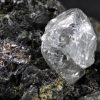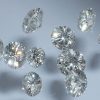Synthetic diamond or Synthesized diamond is a diamond produced in a diamond-producing laboratory. The physical and optical properties of synthesized diamonds are like natural diamonds’ physical and optical properties. The production of synthesized diamonds can be done in similar colors and clarity like any natural diamond.
They cannot be easily detected, and they can be polished. Synthesized diamonds should not be confused with simulant stones that seem like diamonds. Examples of such simulant rocks include cubic zirconia and moissanite. The market of synthetic diamond manufacturers is increasing with every new era.
Synthesized Diamond
Diamond is made up of pure carbon. The optical and hardness properties of diamond are unique as it has a tightly bonded and compact crystalline structure. It was believed that the conditions required for producing this structure for several years were very high pressure and temperature, like the growth environment needed for natural diamonds. Attempts for duplicating the process of manufacturing diamonds were carried out in the laboratory in the 1880s and 1896. These attempts were not successful.
Indisputable proof of diamond synthesis was factually not available until 1955 when General Electric Co’s scientists announced a breakthrough. A thousand-ton press achieved a simultaneous temperature of 5000 Fahrenheit and pressure of one and a half million pounds per square inch. The formation of diamonds from carbon takes place very rapidly(seconds to minutes) in these conditions.
Enormous crystals produced by General Electric were around one carat, and a small number of gems were cut from them. However, the cost of manufacturing synthesized diamonds was so high and the process so challenging that synthetic diamonds could not compete with natural diamonds.
In contrast, synthesized diamond power for grinding was comparatively simple to manufacture and has become a relatively cheap and staple industrial product. Still, the manufacturing of vast and transparent diamonds suitable for gemstone use remained very expensive and technologically elusive.
The diamond trade continued to be immune to the dangerous impacts of undisclosed treatments and synthetics, i.e., the problems that have badly affected the rest of the market for gemstones. This was because natural diamond production conditions of extreme pressure and temperature were not achievable in the industrial or laboratory environment.
Curiously, the incentive to manufacture huge diamonds did not mainly come from the demand for gemstones. It has come to be known that diamonds are amongst the well-known heat conductors. Microelectronics’ miniaturization limitation is the heat’s dissipation produced by electrons moving in these tiny circuits.
The central processing units found in advanced computers produce so much heat that they need a lot of cooling. It had been speculated for a long that a massive rise in component density could be attained by employing diamond as a substrate apart from silicon, resulting in revolutionary progress in miniaturization.
The massive size of this potential market for electronics, fully dwarfing any possible gemstone use, inspired considerable advances in the growth methods of diamond crystals.
Types Of Diamond
The grouping of diamonds is done into many categories. Type one stones comprise either nitrogen in groups (type 1A) or remote atoms (type 1B). Every type 1 stone is an electrical insulator and has absorption bands within the spectrum’s infrared portion. They normally fluoresce yellow in ultraviolet light.
Type one stones can be green, grayish, or colorless (rarely violet or blue), but are usually brownish to yellowish and include the yellowish stones’ cape series consisting of the massive majority of diamonds witnessed in the gems trade. Type two diamonds do not comprise nitrogen and are heat’s good conductors. Type two A stones are colorless, but type two B stones contain boron, have a blueish (sometimes gray or brownish) color, and are conductive electrically.


